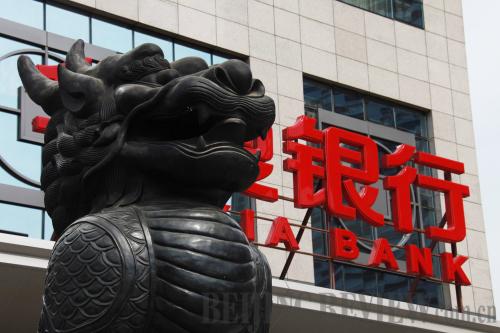|
 |
|
ROLLING OUT MORE MONEY: A branch of Huaxia Bank in Beijing's financial street. China sees rapid growth of bank credit in March, arousing suspicions as to whether the country will ease the monetary policy (XING GUANGLI) |
The People's Bank of China (PBC), the country's central bank, seems to be loosening liquidity to stimulate economic growth.
According to the PBC, in March, newly increased renminbi loans reached 1.01 trillion yuan ($160.32 billion), much higher than the market expected and hitting a record high in the past 15 months.
After the global economic crisis in 2008, China launched a 4-trillion yuan ($634.92 billion) stimulus package to stabilize economic growth. In the meantime, it adopted an eased monetary policy with monthly credit surpassing 1 trillion yuan ($158.73 billion). However, to cope with inflation, China has gradually reduced stimulus efforts, causing the credit scale to drop markedly. In the past year, newly granted loans each month were all much lower than 1 trillion yuan ($158 billion).
The massive growth of monthly credit this time appeared as the Chinese economy has been undergoing a decrease in growth. In the first quarter of this year, China recorded a GDP growth of 8.1 percent, lower than the market expectation. This is the fifth consecutive slowdown of quarterly GDP growth after the first quarter of 2011 and the lowest in three years.
Li Wei, an economic analyst of Standard Chartered Bank, said the massive credit scale growth in March may indicate the government's intention to ease the monetary policy and ensure economic growth.
Wang Tao, analyst of UBS Securities Co. Ltd., said the current figures reflect the government's regulation intentions that both monetary and fiscal policies will be eased.
According to Wang, with the government's practice of allowing banks to grant loans for the construction of affordable houses and other key projects under construction and relaxing control of loans granted to first house purchasers and developers of common commercial houses, the newly added loans in March increased markedly. This also indicates that capital will give more support to the real economy and it is more likely that economic growth will reach the bottom in the second quarter.
After China publicized economic and financial figures for the first quarter, the central bank said it would increase liquidity supplies by various means such as lowering deposit reserve rate, appropriately strengthening reverse repurchase rates and releasing liquidity by expired central bank bills.
Zhu Jianfang, chief economist of CITIC Securities Co. Ltd., said the central bank's recent actions indicate that when maintaining the keynote of being moderate, the government tends to ease the monetary policy to some sectors, with the aim of "transfusing blood" to the real economy in transition.
"The focus of the policy is transferring from controlling inflation to ensuring steady economic growth," Zhu said.
Zhu said that as the European debt crisis rages on, capital flowing to China will slow and the amount of base currency from funds outstanding for foreign exchange will then be reduced. It is still possible that the deposit reserve rate will be further lowered.
| 